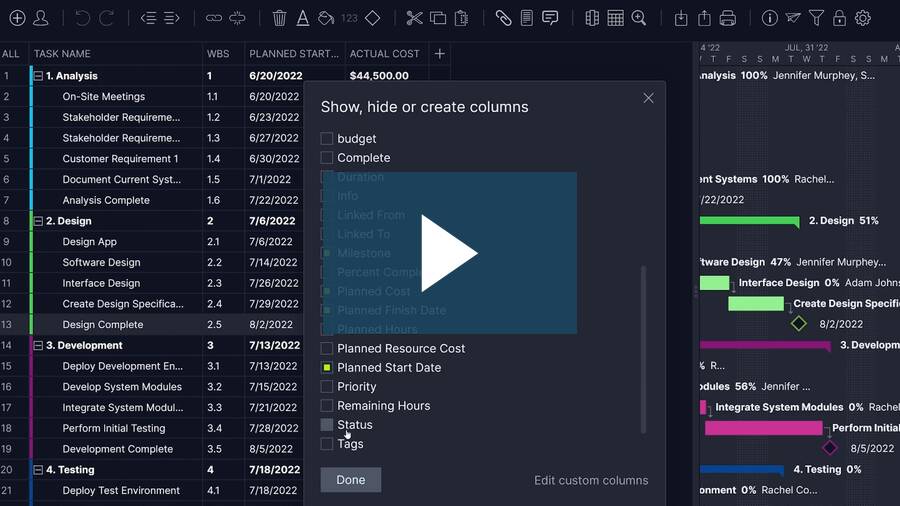- What Is a Program in Project Management?
- What Is Program Management?
- Program vs. Project
- What Is a Program Management Plan?
- What Is a Program Roadmap?
- What Is a Program Manager?
- What Is Program Management Software?
- Benefits of Online Program Management Software
- Must-Have Features of Program Management Software
- Managing Programs With ProjectManager
- Program Manager vs. Project Manager?
- Program Manager vs. Project Manager
- Program Management Office
- How to Become a Program Manager
- Program Manager Career Path
- Program Management Courses, Certifications & Training
- Program Management Templates
- How ProjectManager Helps with Program Management
- Program Management Resources
What Is a Program in Project Management?
A program is a cluster of related projects that are managed in a coordinated manner, so they can be executed simultaneously and share resources, activities and stakeholders.
What Is Program Management?
Program management is a strategic management approach to executing and controlling multiple related projects. The goal of program management is to drive benefits to the entire program by sharing project resources, costs and activities.
Managing related projects simultaneously creates opportunities for synergies that would be elusive if one was to manage each project separately. This requires more complex management than guiding an individual project, as the focus of program management is broader.
Related: 15 Free PMO Templates for Excel and Word
When undertaking the task of managing a program, program managers rely on powerful software tools that allow them to plan, monitor and report on performance. With ProjectManager’s online suite of program management tools, you can make the right decisions for you and your organization.
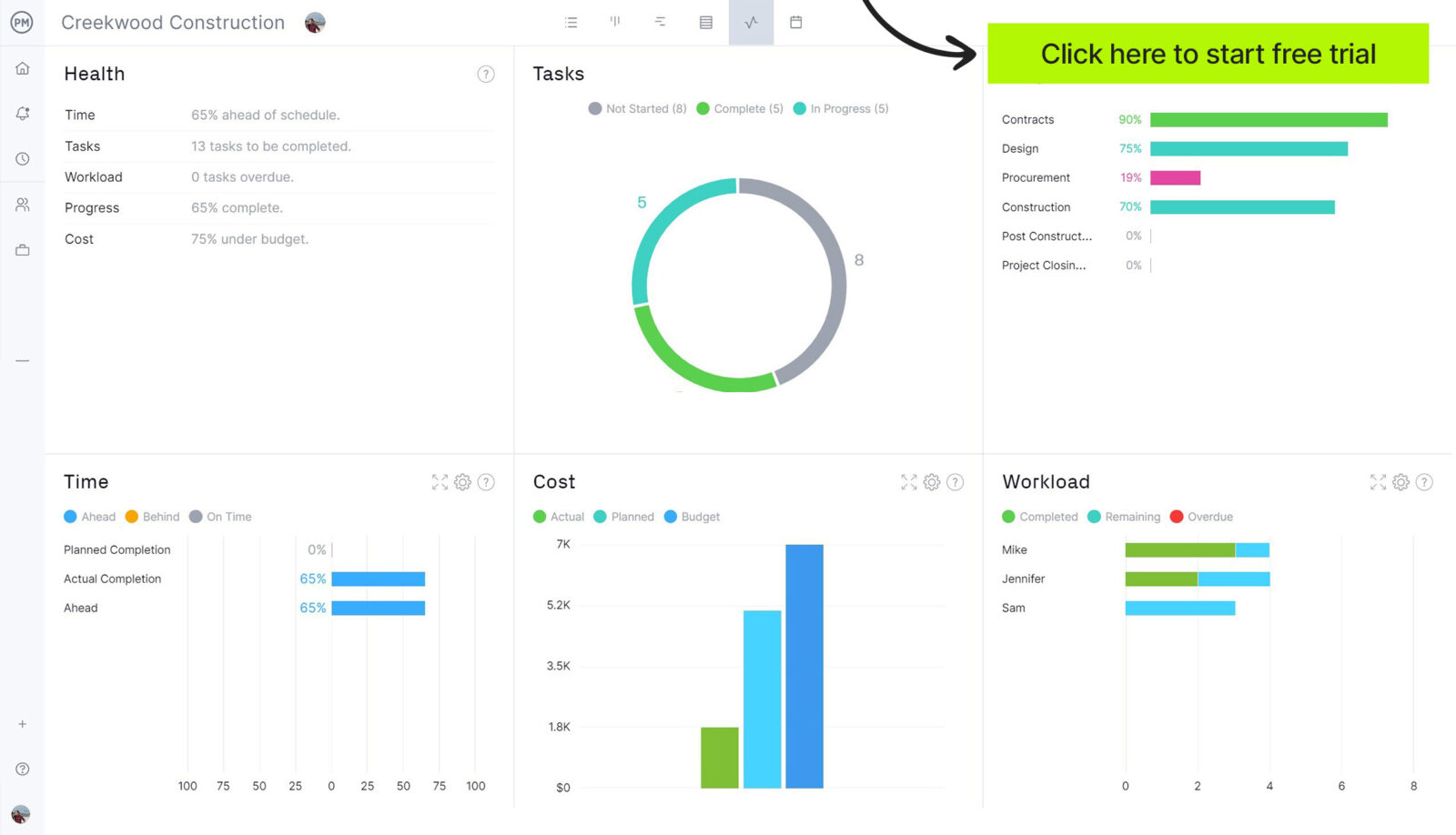
With the help of these software tools, program managers group similar projects into a program. Then, they use various techniques, knowledge and skills to manage them together for the greatest return on investment.
In addition to program management software, you should also make a program management plan and a program roadmap to manage your programs.
Program vs. Project
We’ve established that a program is a set of projects, but there are other key similarities and differences between a program and a project you should be aware of. Here are some of them.
Differences Between a Program and a Project
- Programs are executed to accomplish long-term strategic objectives, while projects have shorter-term goals
- Programs require a larger management team, which can include a program manager, project portfolio manager or program management office
- There are separate certifications, courses and training for program and project management
Similarities Between a Program and a Project
- Programs and projects need to be aligned with the strategic plan of the organization
- Both programs and projects involve cross-functional collaboration and managing organizational resources
- Project portfolio management software can be used to manage both projects and programs
What Is a Program Management Plan?
A program management plan is a document that describes the most important aspects of a program and establishes the guidelines, procedures and documentation that will be used to manage it.
There is no one-size-fits-all outline for a program management plan, as you can choose how detailed you’d like it to be. We suggest including these basic elements.
- Program Goals and Objectives
- Program Timeline
- Program Budget
- Resource Management Plan
- Change Management Plan
- Program Management Team
- Risk Management Plan
Now let’s review what a program roadmap is and how it helps with program and project portfolio management.
What Is a Program Roadmap?
A program roadmap is a visual tool that shows the timeline of multiple projects. Program roadmaps are usually created using Gantt charts, which show the tasks for all projects, their duration, percentage of completion, dependencies between them, and due dates.
Besides tracking project timelines, a program roadmap should also allow you to track costs, budgets, resource utilization and other aspects of your program.
For example, ProjectManager offers multiple program management tools such as Gantt charts, real-time dashboards, timesheets, workload charts and more, so you can create a fully-fledged program roadmap for planning, scheduling and tracking programs.

Program Management vs. Project Management
Programs are created from a business high-level view, while projects are much more specific. A program plan is meant to achieve the strategic goals and business objectives of organizations. They have flexible deadlines and seek long-term benefits. On the contrary, projects have strict deadlines and seek quality control, timeliness and cost-effectiveness to produce deliverables.
The major difference between program management and project management is that the scope of a program is much broader and more adjustable, while a project is defined by its deliverables. Programs are a persistent exercise, while projects have defined start and end dates, which are specified in the project plan.
Achieving the strategic plan and strategic vision of an organization usually requires long-term programs that consist of various individual projects. The program governance and program management plan define how those projects will be executed. Large organizations usually need to execute several programs at a time, which are part of their project portfolio.
Program Management vs. Project Portfolio Management
Program management is not the same as project portfolio management. The Project Management Institute (PMI) defines a project portfolio as “projects, programs, subsidiary portfolios, and operations managed as a group” in its Project Management Body of Knowledge (PMBOK) book. So, in simple terms, a project portfolio is the larger group of projects and programs that an organization is executing at some point.
Related: Free Project Prioritization Matrix Template for Excel
What Is a Program Manager?
The program manager role generally requires an individual with a program management certification. A program manager is responsible for overseeing the life cycle of a program by working with different teams, project managers, portfolio managers and stakeholders.
What Does a Program Manager Do?
A program manager is a Program Management Professional (PgMP) who specializes in the strategic management of a group of related projects and attempts to create efficiencies and achieve the strategic goals and objectives of the organization they work for.
Program managers will participate in the project intake process, work across multiple projects to build on interdependencies, direct the project managers who manage the individual projects in the program and facilitate communication between cross-functional teams.
Program Manager Responsibilities
Among other duties, the main responsibilities of a program manager are risk management, quality control, change management, managing stakeholder communications and reporting.
Program managers also have to collaborate with program directors and portfolio managers to make sure that their program plan aligns with their organization’s program portfolio management plan.
These are the responsibilities that a program manager typically must account for in their day-to-day duties:
Program Initiation
Before a program can be managed, it must be built through a process of gathering project ideas, selecting and prioritizing them.
To do so, the program manager must carefully evaluate various project proposals to determine which potential project ideas can be managed together as a program to bring the most benefits to the organization.
To do so, the program managers work collaboratively with project managers, project management offices and project portfolio managers to establish a project selection criteria that will allow them to prioritize the execution of projects based on financial, strategic and operational factors.
Program Planning
Program planning is where program management starts, and ensuring that your program plan is built properly is of utmost importance. Having a well-thought-out program management plan saves time and money, and allows program managers to anticipate risk and preliminarily lay out methods to resolve it. Like any plan, a program management plan breaks down the larger chunks of work into smaller, more manageable bits. A program work breakdown structure allows program managers to do just that.
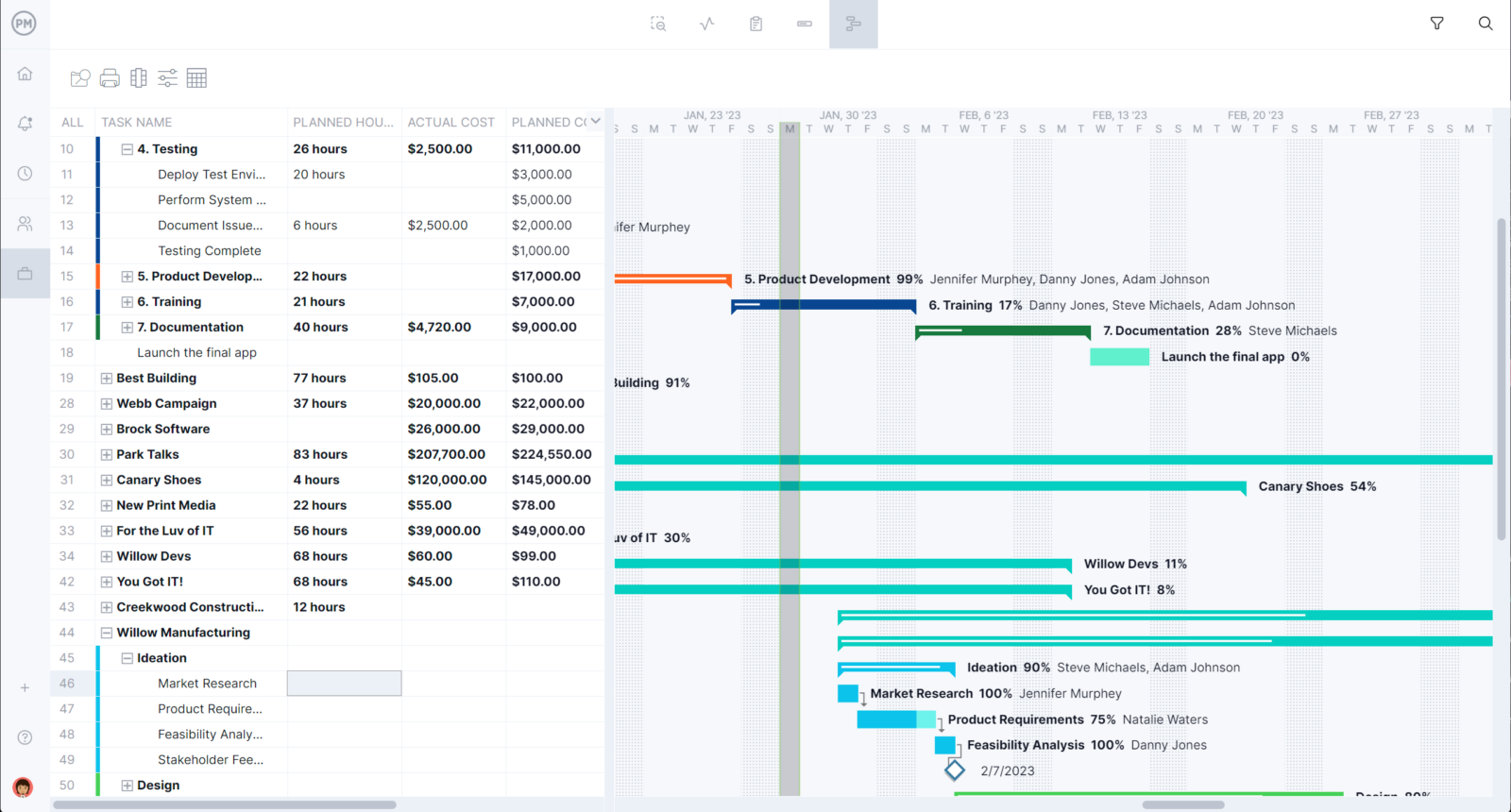
Cost Control
Programs cost money to run, and how much of a financial commitment the program will require must be estimated upfront. Therefore, once a basic program plan is in place, it’s up to the program manager to figure out how much it will cost to run. The more accurate this analysis, the better for the organization’s budgeting in the long term.

Program Management
With a plan in place and the money to fund it, the program manager must manage the execution of the various projects in the program. Program managers typically live on tools like Gantt charts, which are essential to tracking program success.
With a Gantt, program managers can break down their programs into phases, and can drill into their constituent projects down to the task level. These program management tools allow program managers to use real-time data as input for their decision-making process, which is a program management best practice.
Change Management
Projects always change, so it stands to reason that programs that hold those projects must change as well. Program managers must have change management processes in place to manage those changes. Changes can come from stakeholders or internally and they can also be external changes due to supply chain, weather and other forces. Wherever they originate, these changes must be identified, approved or denied and then responded to.
Program Manager Skills & Qualifications
Program management is a challenging discipline that requires program managers to have a set of hard and soft skills. Here are some of them.
- Solid understanding of project management, business administration, strategic planning and other related disciplines
- Communication and leadership skills
- Ability to work well with others, solve conflicts and be empathetic with program stakeholders
- Proficiency with project portfolio management (PPM) software
- Knowledge of project management methodologies such as agile or waterfall
- Knowledge of project management areas such as risk, resource, cost and schedule management
- Resource forecasting, planning, scheduling and monitoring tools and techniques
- Ability to build the project management maturity of organizations through employee training and implementation of project management tools and techniques
What Is Program Management Software?
Program management software is the most valuable asset of a program management office. It allows managers to plan, organize and manage their resources across an array of projects and set up an appropriate program governance.
It’s designed to control the scheduling of multiple projects and their related costs, budget, resource allocation and more.
Every program management software is slightly different, some offering more holistic features, while others focus on specifics related to finding and capitalizing on the synergies between projects in the program.
At a bare minimum, you’ll want a tool that can manage tasks, has a communication platform that keeps everyone on the same page and a means to monitor and track progress. Microsoft Project is one of the most commonly used project management software, but it has major drawbacks that make ProjectManager a better choice for program management.
Benefits of Online Program Management Software
Having an online program management software that can help you coordinate the management of the many projects in your program is essential. Here’s how it can help:
- Facilitate the project planning process
- Collect projects into program governance groups
- Facilitate resources throughout program
- Gather program details in one-click reports
- Live data to make better decisions
- Display live metrics on program management dashboard
- See and balance your team’s workload from same page
Must-Have Features of Program Management Software
When you’re looking for an online program management software, it should meet certain criteria. Whatever tool you invest in, make sure it has these features:
Get Visibility Down to the Task Level
Gantt charts are visual tools that place tasks on a timeline, which is key to planning and scheduling your projects. Program management software can also use a Gantt chart as a program roadmap that shows all the projects in your program on one timeline to highlight key metrics.

Stay on Track With Real-Time Metrics
Dashboards collect data from your program and display them in graphs and charts. You want a dashboard that doesn’t have to be manually configured and automatically calculates various metrics for a quick, high-level view of your progress and performance.

Stay Updated on What You’re Spending
To stay on budget, you have to have a means to monitor and track the costs associated with your program. Resources must be allocated where they’re needed in the program without overspending. Having a feature that tracks your budget-to-cost ratios helps you do this.
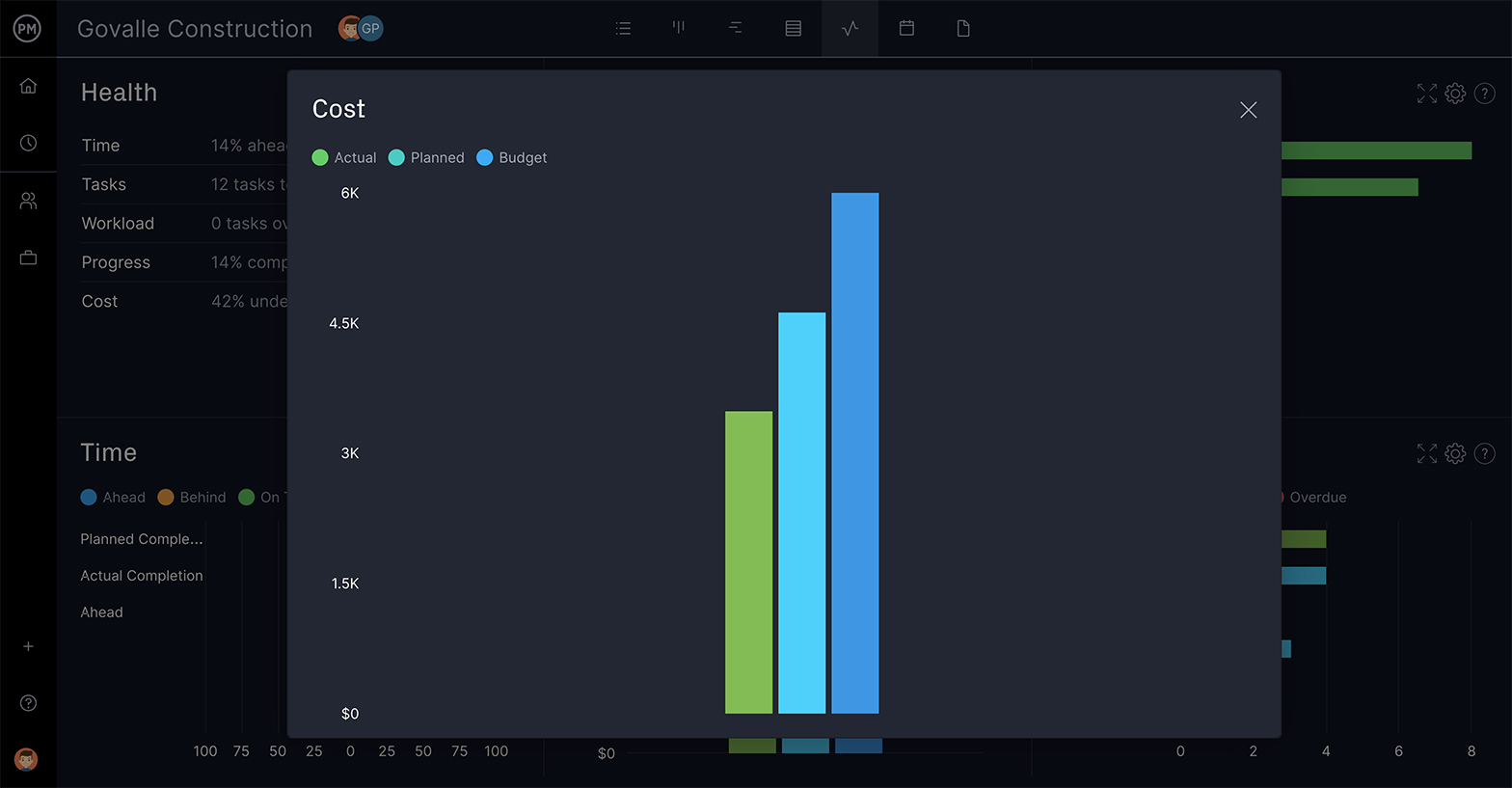
Know How Much Time Your Team Is Logging
Keeping track of the time spent on tasks is essential to staying on schedule. Timesheets can offer more than a way to streamline your billable hours, they track the hours your team works. You can estimate how long tasks will take, then compare actual progress vs. planned.
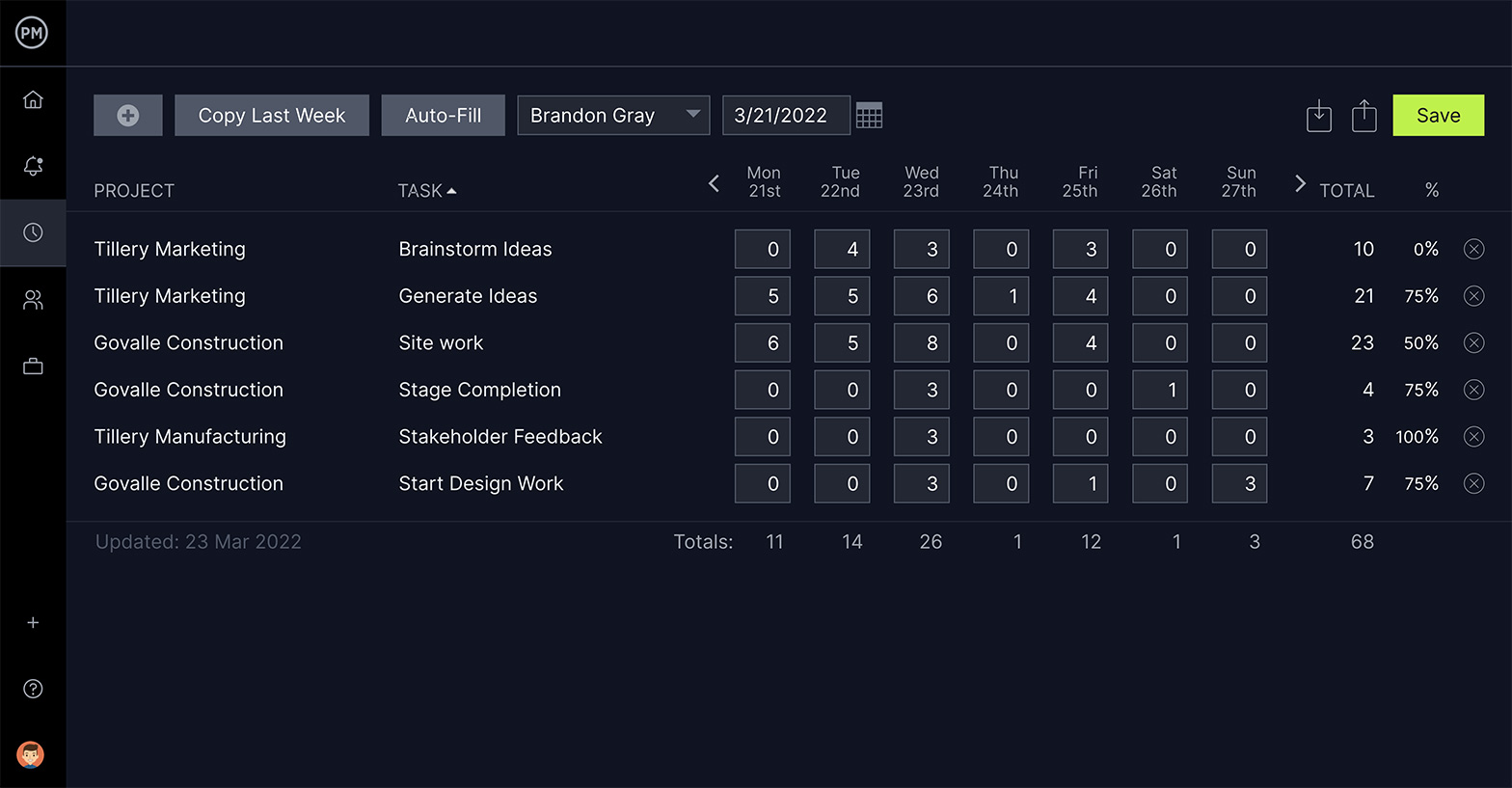
Control Teams & Tasks Across Program
Programs are successful when the details of each individual project are controlled. Some projects in your program might have overlapping teams, so you need a feature that lets you manage their tasks and allocated hours to keep their work efficient.
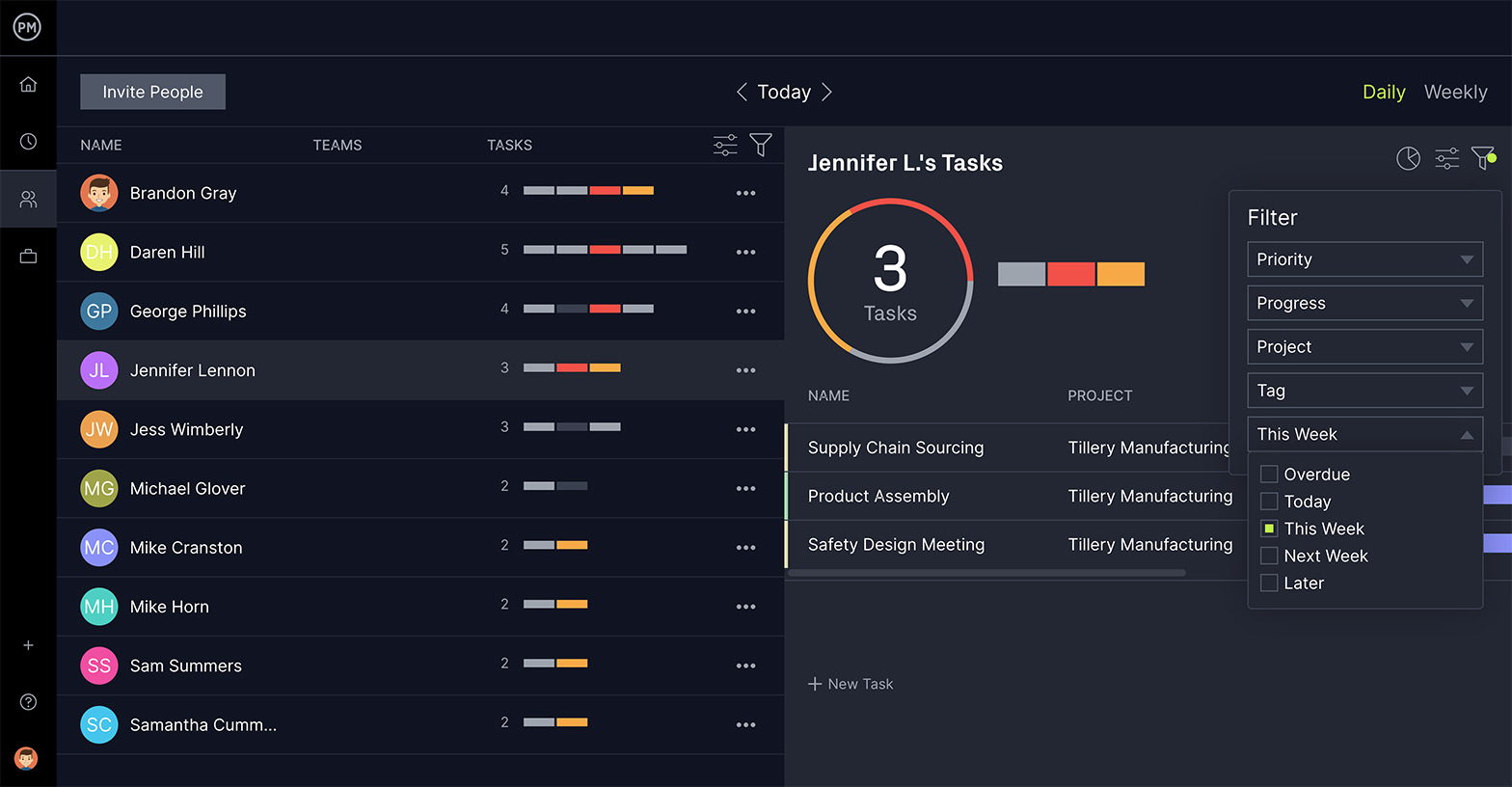
Manage Tasks Visually
Program managers need transparency into their teams’ work in order to keep things moving smoothly forward. Kanban boards visualize workflow and help managers allocate resources as they’re needed. They see the production cycle for each project and can clear roadblocks.
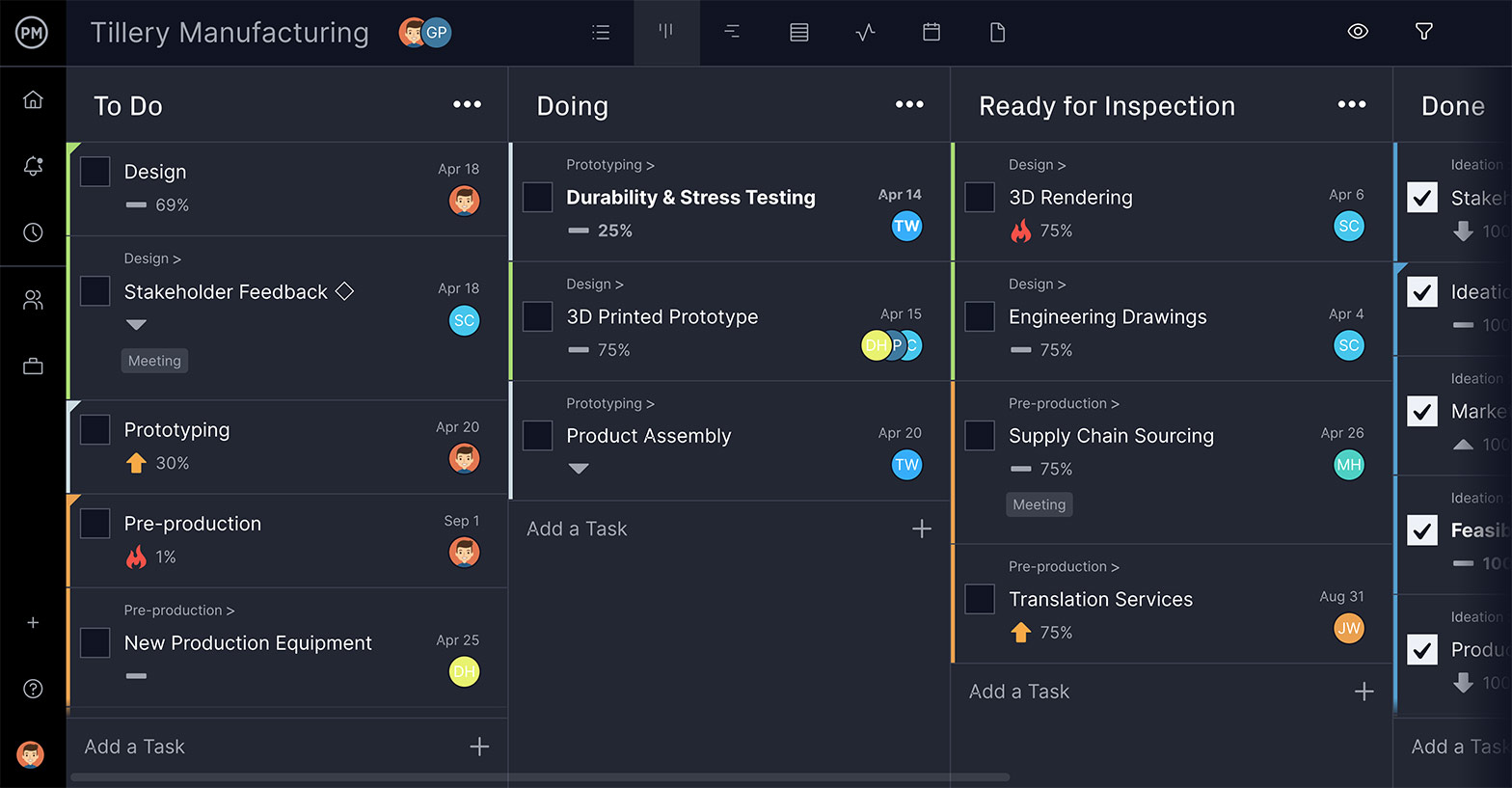
Managing Programs With ProjectManager
Program management software is a tool that helps collectively drive efficiency across all your projects. It helps program managers to plan, manage, track and report on progress and performance in their programs— and provides total transparency into that process.
ProjectManager is an award-winning project management tool that assists in organizing projects and programs with cloud-based features to make data-driven decisions. Here’s how it works.
1. Create Your Program
A program is made up of multiple projects. The first step in any project management program is to collect all related projects that work together as a program.
Import the projects in your program into our software from task lists, or use one of our industry-specific templates to create the project from scratch.

2. Set High-Level View
Not all programs are the same. You need a tool that will adapt to your way of working and not make you fit into its rigid structure.
Customize your program to show the only data you need for your decision-making process. Status bars by each project show progress, cost/budget and more. Profile pictures or avatars for managers and teams allow for rapid insight on who is assigned to a certain project.

3. Group & Filter Projects
Programs are groups of similar projects synergizing with each other in ways that enhance the overall value of each project. That doesn’t mean, however, that programs are singular. In fact, organizations often have many to manage in their project portfolio.
Add projects to folders to create program groups. Title and filter these groups, then monitor their performance with our program dashboards that collect real-time data.
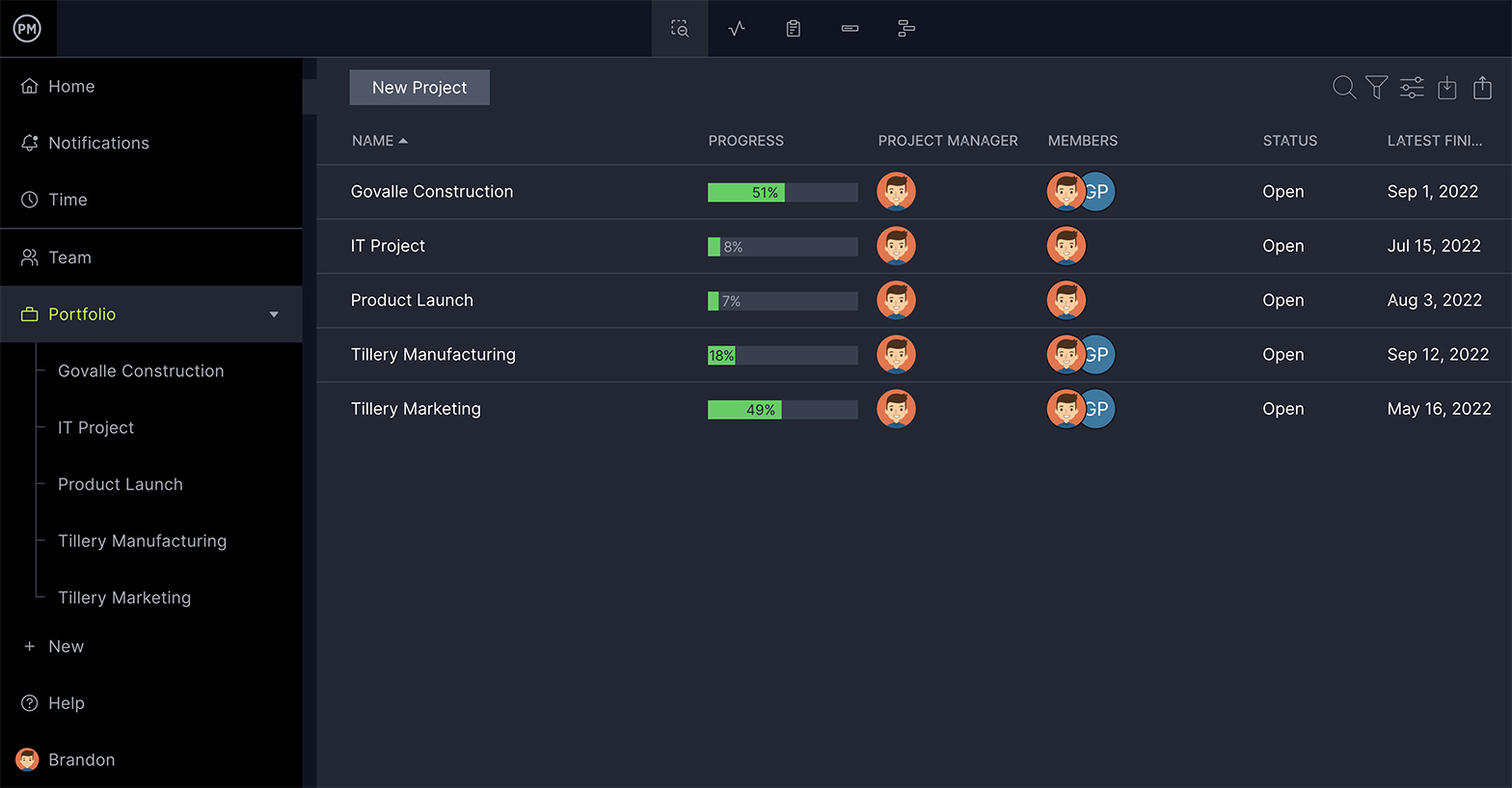
4. Set up Notifications
Staying on top of progress and changes is key to reaching the program goals. Getting notifications promptly ensures that they won’t get lost in the shuffle, and lets a program manager stay informed and in control.
Get updates both by email alerts and in-app notifications. Manage emails to alert you of comments, updates and more. The bell icon on our tool gathers your notifications in one place.
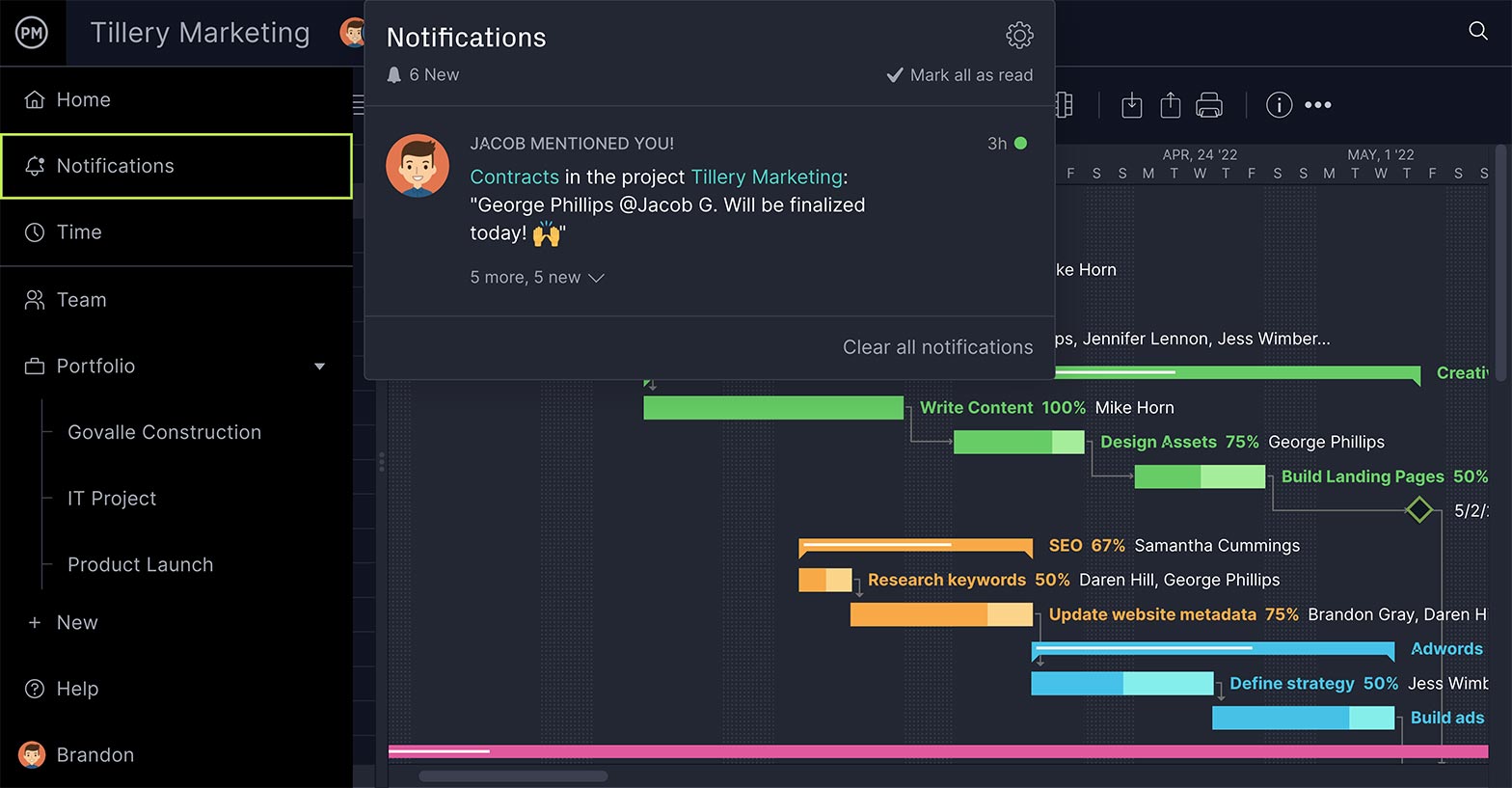
5. Balance Resources
Keeping your resources matched to the capacity of your program is one way to maximize performance. That includes your team members!
Manage the resources in your programs from our color-coded Overview Workload page. See at a glance who on your team is overallocated, and balance their workload right from the page to boost productivity.
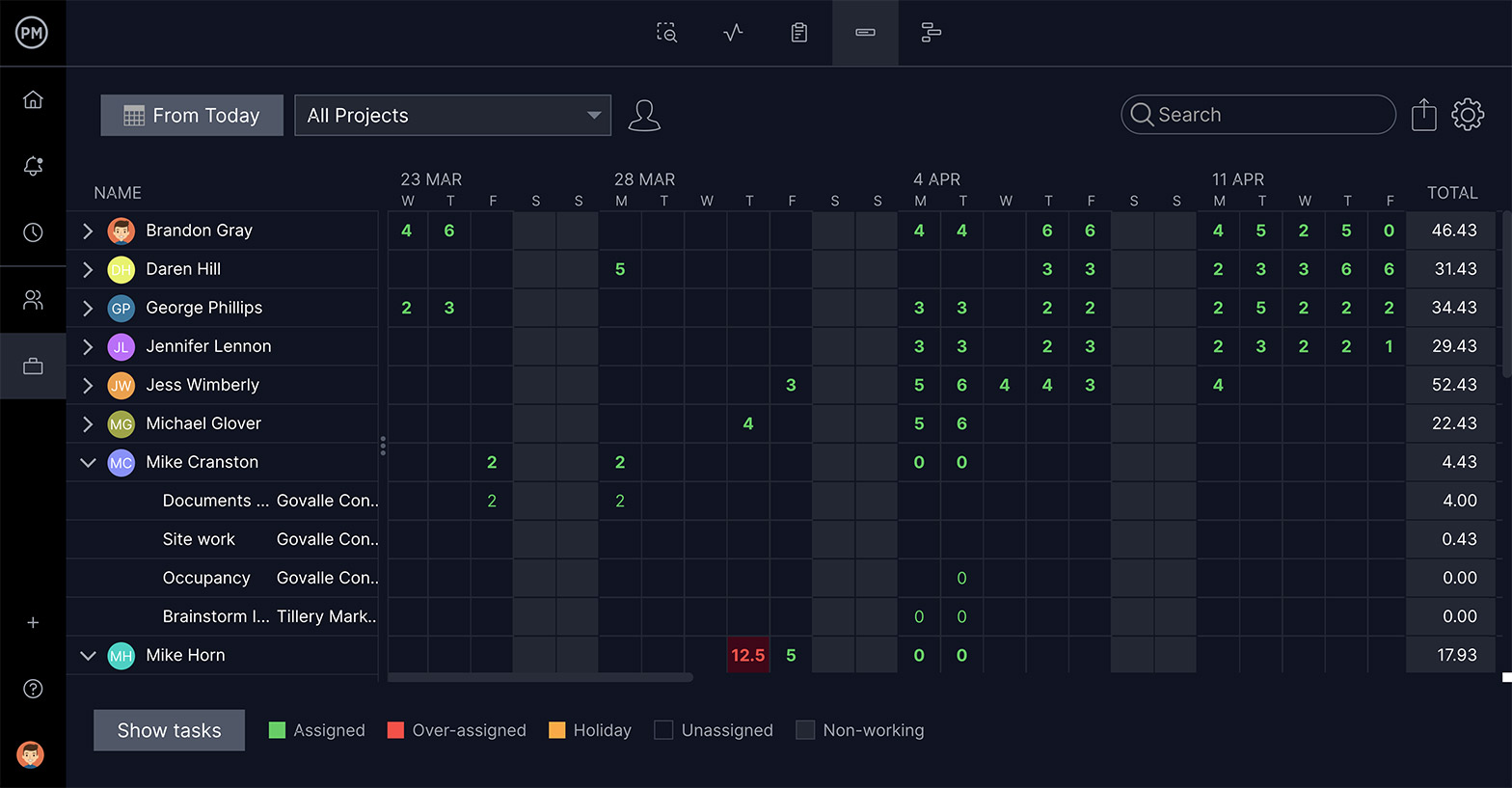
6. Keep Track of the Program
Programs are designed to help individual projects work together and achieve greater efficiency. Therefore, you need to see how all the projects in your program interact.
Use the Roadmap feature to view all the projects in your program on a single timeline. View the start and end dates for each to ensure there are no bottlenecks, and even drill down to the task level for each project.
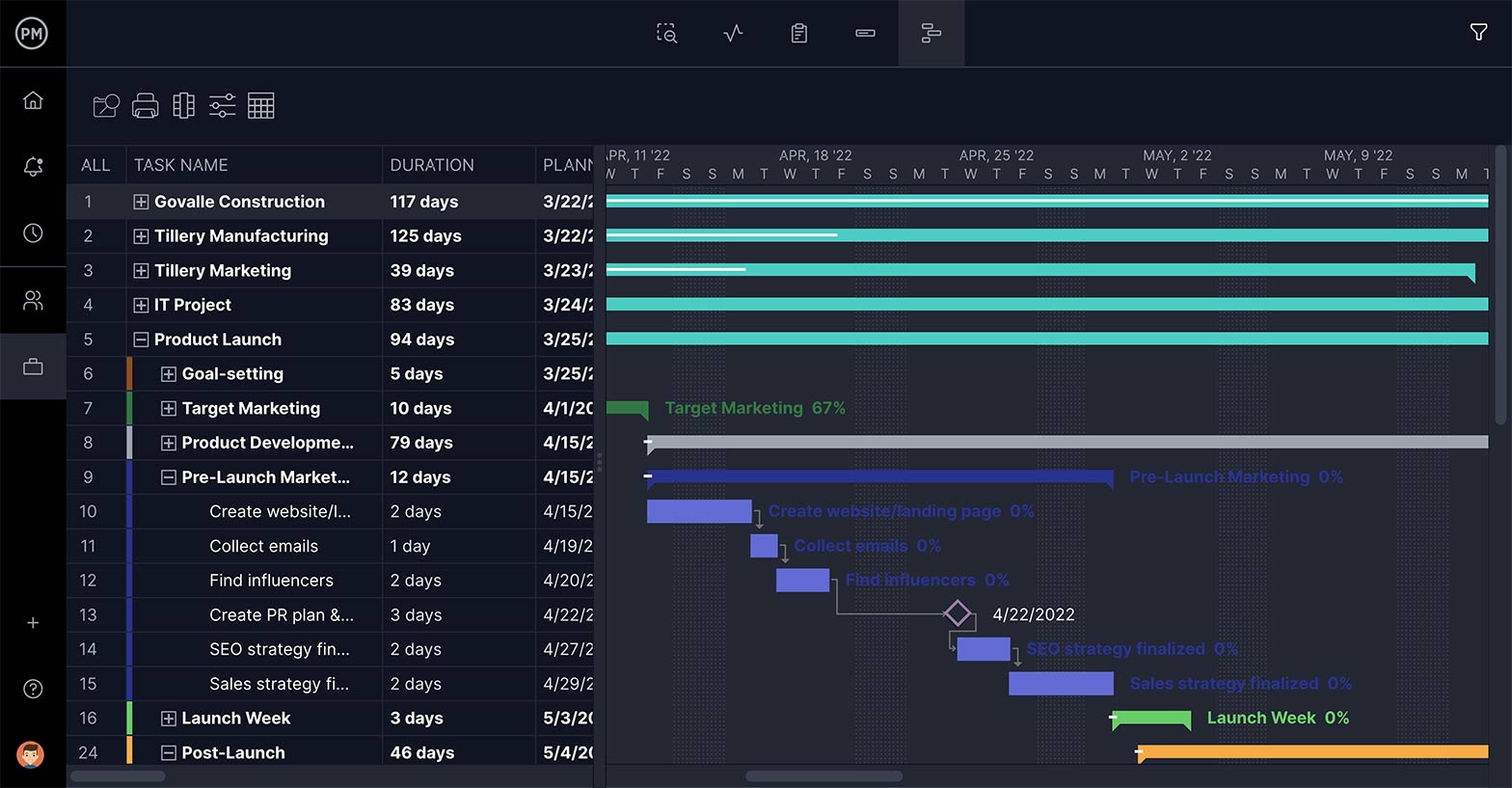
7. Report to Stakeholders
Transparency is important when dealing with stakeholders. If they feel out of the loop, they’re going to interfere with the management of the program. ProjectManager helps you execute your communications plan.
Keep your stakeholders informed with one-click reports. You can filter the data to show just what they want about status, various and more, then share it as a PDF or printout.
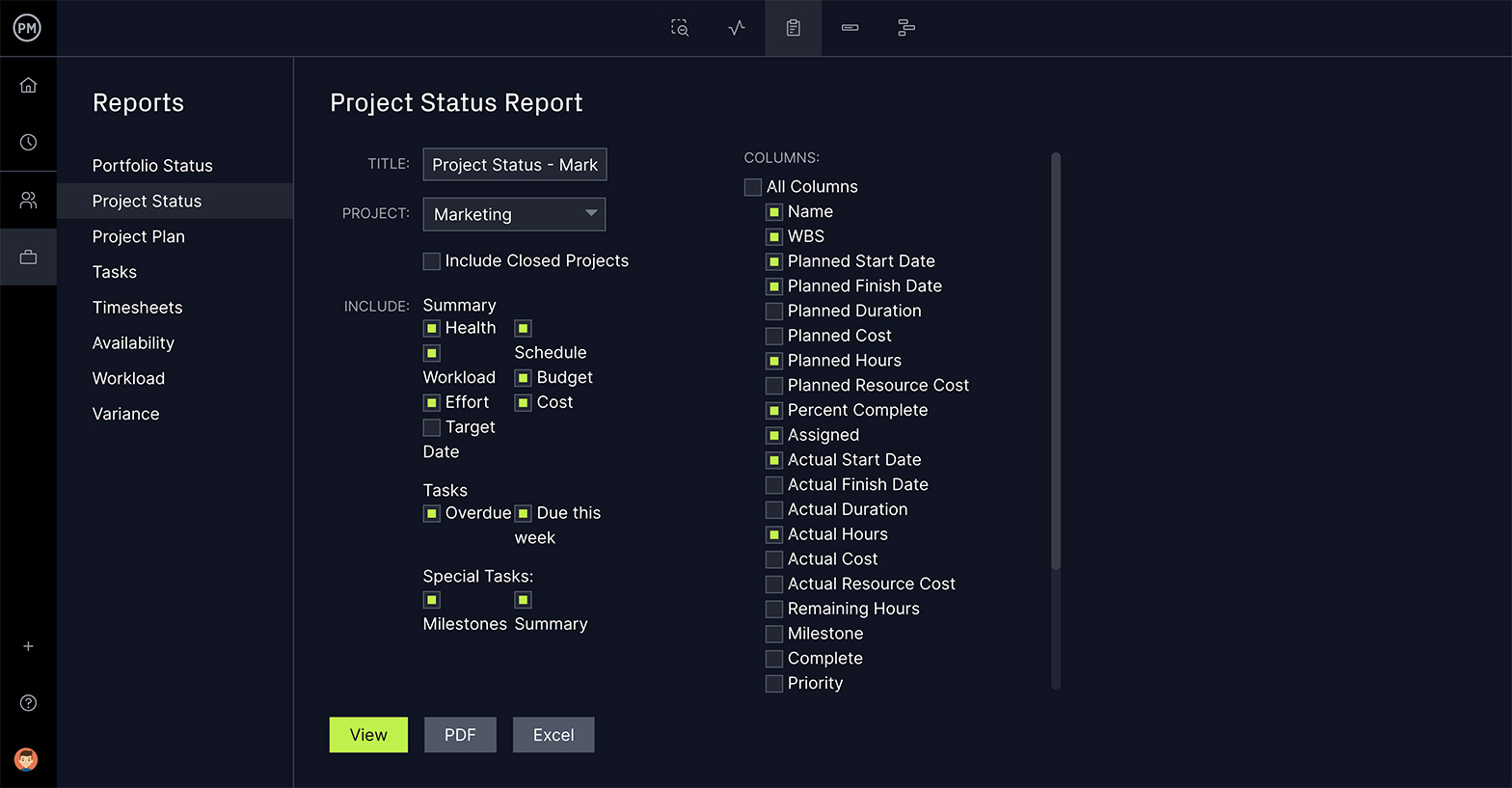
What’s the Difference Between a Program Manager and a Project Manager?
Even though they’re both project management roles, they’re not interchangeable. As we’ve mentioned above, a program and a project are two completely different things, and that’s why the responsibilities of a program manager differ from those of a project manager.
A program management certificate differentiates program managers from project managers, project coordinators and project portfolio management professionals. For example, the Project Management Institute (PMI) issues the Program Management Professional (PgMP) certification that’s exclusive for program managers.
Program Manager vs. Project Manager: Key Responsibilities
The qualities of a great program manager include being more diplomatic and strategic than their project manager counterparts to manage stakeholders, project managers and team members with varying project goals. To achieve program goals, they have to interact with many cross-functional teams and align all their projects with the program plan.
This differs from a project manager in that project managers are required to be detail-oriented and great with numbers, with an eye for hyper-efficiency to keep individual projects on track, but are not necessarily expected to be diplomatic, and don’t need to communicate with as many people as program managers.
Additionally, program managers are big-picture thinkers who must understand the strategic management thinking behind the development of a program plan. In other words, they must be able to align their programs with the strategic vision and strategic plans of their organizations. To do so, they have to begin by creating the program plan and program governance.
Once the planning is done they have to oversee execution, control the program and collaborate with project managers and stakeholders. On the flip side, project managers are not necessarily worried about the big picture goals of their organization. Their only goal is to oversee the planning, scheduling and execution of their projects.
Unique challenges that many program managers face include:
- Creating a program plan and project governance model to manage multiple projects at once
- Keeping all project managers and projects aligned on the singular big-picture business objectives
- Managing stakeholders’ expectations and ensuring that all project members are on board
- Verifying that all budgets and resources are available at multiple points throughout the program
Whereas project managers face the unique challenges of:
- Managing the detailed elements of a single project
- Tracking, quantifying and reporting on the specific ups and downs of their project status
- Allocating resources, budget, dependencies, time and tasks—while mapping them out within a given project scope
- Planning, budgeting, monitoring and reporting on the progress of their project
There are also portfolio managers, who are different from both project managers and program managers in that they deal with choosing, prioritizing and ensuring that all projects and programs make sense for the company’s objectives. Additionally, they are focused on getting the most value for the money it takes to roll out a project by using thorough research to identify the correct time and place for the rollout.
Project managers, program managers and portfolio project managers usually work together in a program management office.
Program Management Office
The program management office operates as any other business department of a company such as accounting, production, marketing or sales, but its sole purpose is to manage projects, programs and portfolios.
The main mission of a program management office is to make the most efficient use of the organizational resources of a company by ensuring programs are executed on time and budget and prioritizing the projects and programs that contribute the most to the accomplishment of strategic planning objectives.
Program management offices can vary in size depending on the organization, ranging from a few members to dozens of project and program managers.
How to Become a Program Manager
Program management is a complex discipline that takes years to master as you’ll need formal training, certifications and hands-on experience. So if you’d like to become a program manager, you must plan for the future.
While there might be many paths that can lead you to becoming a program manager, we’ve outlined the most common program manager career path, certifications, courses and training programs so you can get a better idea of what this journey looks like.
Program Manager Career Path
The first step to becoming a program manager is to obtain a bachelor’s degree in business management and then build a career in project management, as program managers are typically required to have a minimum of at least three to five years of project management experience.
Once you’re ready, you should get a program management certification, which will allow you to apply for program manager positions. Then, it’s advisable to choose a specific industry to specialize in and obtain any relevant skills and certifications so you can advance in your career faster.
As you become an experienced program manager, accomplish professional goals and improve your skills, your career path can grow into senior or executive program management positions.
Program Management Courses, Certifications & Training
The most popular program management certification is the Program Management Professional (PgMP) certification by the Project Management Institute (PMI), which has become the standard in program management.
To even qualify for this program manager certification, you have to have a secondary degree, plus 6,000 hours of project management experience and 10,500 hours of program management training. For program managers with a four-year degree, however, it only takes a little bit of program management experience plus 6,000 hours of project management experience.
Getting a program management certificate from the PMI shows that you’re serious about program management and that you not only have the experience needed to rise to the top of a resume pile but also have the actual program management training it takes to make projects successful on a company-wide level.
In addition to this program management certification, there are other program management certifications, courses and training programs such as these three examples.
- Portfolio Management Professional (PfMP) by the Project Management Institute
- MSP®: Managing Successful Programmes by Axelos
Certified Project Director by the Global Association for Quality Management - Master Project Management by the American Association of Project Management
Program Management Templates
To manage a program, you’ll need to create lots of documents and reports which is why we’ve created dozens of project and program management templates that can help you save time and standardize your program documentation.
Program Management Industries and Roles
Since program managers are similar to change agents, there can be many roles to fulfill at one time, including planning coordinator and senior user. They need to have the people skills to be able to be an effective communicator and leader, but at the same time need the analytical skills to objectively view and report on their projects’ successes.
Many program managers are located in Silicon Valley, Washington D.C. and Chicago, IL as many program managers work in IT companies, the tech industry, construction management, the engineering industry and others.
How ProjectManager Helps with Program Management
ProjectManager has everything you need to manage projects, programs, stakeholders and team members. Our cloud-based tool gives you access to Gantt charts that let you create dependencies across tasks in different projects in your program.
You can also have automated reporting that lets you track portfolio status, project status, workload and more. Our workload features even allow you to track how your team is being best utilized within the different projects in your program.
Program management is a deeply involved, high-level practice that includes one individual or a team of program managers overseeing multiple projects. Without proper tools in place to manage all of the projects and portfolios at once, important tasks can slip through the cracks. Start a free 30-day trial of ProjectManager today and get award-winning program management tools to make your life easier.
Program Management Key Terms
Many terms used in program management are the same as those in project management. It’s still helpful to run through the bigger ones to better communicate what program management is and how it differentiates from project management.
- Program: In project management, a program is a group of several projects that must be executed simultaneously to get benefits and achieve program goals that wouldn’t be obtained by managing them individually.
- Program Management: Is the application of program management skills, techniques and tools to plan, execute and control programs. It’s also called programme management.
- Program Management Office: Similar to a project management office, the program management office helps members across organizations to get involved in the execution of programs.
- Milestone: Marks the beginning or end of a phase in an individual project, usually around related deliverables. Helps track progress.
- Stakeholder: Anyone with a vested interest in the project or program.
- Baseline: Used to measure performance by capturing the schedule, cost and scope of a project plan. Then actual progress can be compared against this.
- Triple Constraint: Three areas that impact any project or program are time, scope and cost, which must be balanced to maintain progress. Quality is often included as the fourth point on this triangle.
- Program Governance: Refers to all the different actions that are taken to monitor and control the success of a program at every stage of its life cycle, such as meetings, reporting, risk management and change management among other elements of governance.
- Program Plan: A program plan is a set of documents that are developed to guide the program execution and monitoring. It’s also known as the program management plan.
- Program Management Framework: Encompasses every component, participant, process, tool and methodology required for a program.
- Program Portfolio: A group of programs and related activities that can be executed collectively to meet strategic goals and business objectives. Program portfolio management refers to the actions taken by management to successfully handle program portfolios.
- Program Life Cycle: Made up of five stages, formation, organization, deployment, appraisal and dissolution.
- Foundation Stage: The iterative process that defines the program’s expected benefits by analyzing the expectations of stakeholders.
- Organization Stage: Creating the program’s business case, program management plan, program governance, operational procedures, etc.
- Deployment Stage: Delivering capacities of the program’s projects on a cyclical basis.
- Appraisal Stage: Assessing program benefits and evaluating whether they meet expectations, done repeatedly throughout the program life cycle.
- Dissolution Stage: Agreement among stakeholders that it’s time to close out the program.
- Roadmap: Gantt chart timeline that gathers all the projects in a program and charts them together down to the task level.
- Risk Management: A way to identify potential issues that can arise in a program and have a plan in place to reduce their impact if they do occur.
- Business Plan: Describes project or program goals and the strategies to achieve them.
- Program Work Breakdown Structure: Defines the work and results necessary to complete the program. It differs from a project work breakdown structure because it’s produced from a broader, program-level perspective.
- Change Management: Method to manage change, whether internal or external, a formalized process involving identifying, planning, tracking, etc.
Program Management Resources
Software
Templates
Articles
- Best Program Management Tools for Managers
- What is a Program Manager and What are They Responsible For?
- Program Manager Job Description – Plus! Cut & Paste Example
- Program Manager vs Project Manager: What’s The Difference?
- The Difference Between a Project and a Program
- Enterprise Environmental Factors in Project Management
- Organizational Process Assets: Definitions, Examples & Templates
Start your free 30-day trial
Deliver faster, collaborate better, innovate more effectively — without the high prices and months-long implementation and extensive training required by other products.
Start free trial